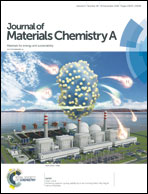Nanoionic transport and electric double layer formation at the electrode/polymer interface for high-performance supercapacitors†
Abstract
Manipulation of ionic charges in the solid electrolyte interface can result in unprecedented device characteristics for energy conversion and storage applications. Planar device architecture with an ultra-thin solid polymer electrolyte film is considered as an essential approach to demonstrate electric double layer capacitance (EDLC) characteristics at interfaces. Due to the synergistic effect of self-aligned polymer structure and higher ionic conductivity of PVA–KOH, the Pt/PVA–KOH/Pt planar micro-supercapacitor (MSC) shows excellent volumetric capacitance of 5.39 F cm−3 with ∼98% capacitance retention up to 11 000 continuous cycles. Furthermore, Pt/PVA–KOH/Pt planar MSC consisting of five series cells extends the operating cell voltage of 5 V with outstanding volumetric energy and power density of 2.36 mW h cm−3 and 0.3 W cm−3, respectively. It is found that the large concentration of ionic distribution at electrode/electrolyte interfaces has a strong impact on dynamic supercapacitance characteristics. Origin of the electromotive force and the effect on chemical potential gradient of dissolved ionic carriers in the interface have been systematically studied to understand the electrical double layer formation mechanism. These results indicate the importance of the confinement effect of the solid polymer electrolyte in determining and controlling not only supercapacitance behaviour but also EDL-based electronic device characteristics.



 Please wait while we load your content...
Please wait while we load your content...